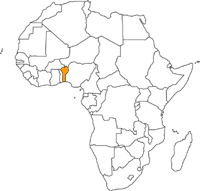 |
National Parks
- Boucle de la Pendjari (www)
- W (Benin)
Hunting Zones
Bird Reserves
- Reserve de la biosphere du Djessin
Reforestation Areas
- Abomey
- Barage de Natitingou
- Kandi
- Kouandé
- Natitingou
- Parakou
- Taneka
Other Areas
- Lake Ahémé
- Lake Nokoué
- Pobè Forest
Wetlands of International Importance (Ramsar)
- Basse Vallée de l'Ouémé, Lagune de Porto-Novo, Lac Nokoué
- Basse Vallée du Couffo, Lagune Côtiere, Chenal Aho, Lac Ahémé
World Heritage Convention
UNESCO-MAB Biosphere Reserves
- Region "W" du Benin
- Reserve de la biosphére de la Pendjari (www)
|
Protected Areas in Benin
From 1894 to 1960 Benin was a French colony known as Dahomey, which together with the present day territories of Burkina Faso, Côte d'Ivoire, Niger and Mali, formed part of the country of French West Africa, created under French colonialism.
Most legislation relating to nature conservation is based on old forestry texts of French West Africa.
The first national parks in West Africa were created by Arrêté No. 6009/SET of 19th August 1954, including Parc national du "W", which extends across the border of Benin, Burkina Faso and Côte d'Ivoire.
Legislation providing for protected areas has also been produced since independence in 1960.
Administration and management of protected areas are assured by the Department of Water, Forests and Hunting, known today as Department of Forests and Natural Resources (Direction des Forêts et des Ressources Naturelles). This Department is subdivided in six forest inspections. For a number of years, FAO and UNDP have been assisting the Benin government in development and management of its protected areas.
This has resulted in the development of management plans for both national parks, and a number of detailed recommendations covering not only protected areas but also national conservation policy, tourism and conservation of sites and hunting (including sport hunting, subsistence hunting and game ranching).
There are, however, problems in implementing these proposals due tolack of qualified staff (Sayer et al., 1979). Protected areas management to date has largely not been effective, due to a lack of surveillance personnel. This has resulted in uncontrolled poaching and brush fires (which are gradually opening up savanna areas), the presence of cattle during certain seasons, and illicit clearance of natural vegetation.
Sources: UNEP-WCMC; World Database on Protected Areas
|
|


